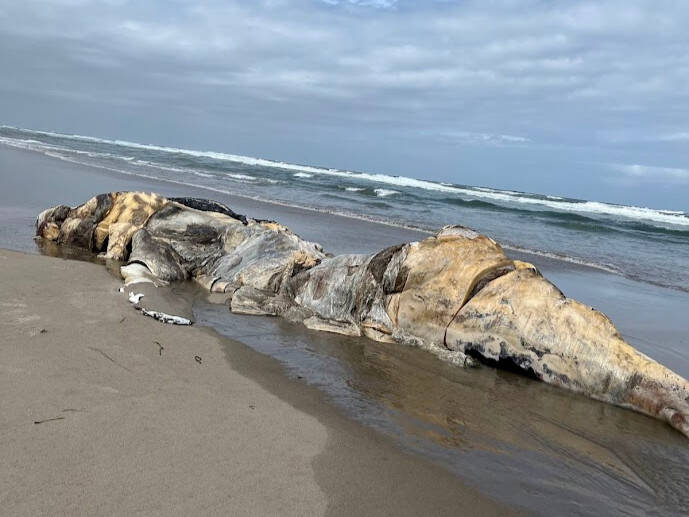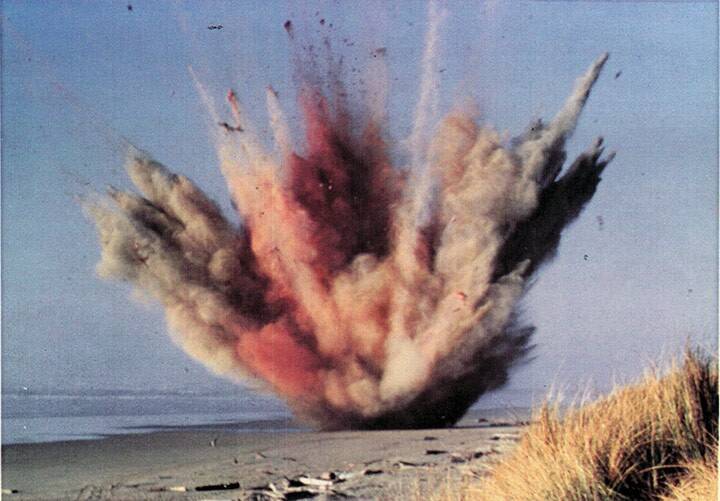When a dead whale washed ashore on an Oregon beach in late May, it called to mind an incident in 1970 when the state detonated a beached whale with dynamite. This time, however, the state parks department was adamant: "History isn't repeating itself."

Oregon State ParksThe decaying remains of the dead humpback whale that washed up in Nehalem Bay State Park in late May.
When a dead whale washed up on the beaches of Florence, Oregon in November 1970, the state made the infamous decision to deal with it in a rather unconventional way: by blowing the whale up. Instead of blowing the remains out to sea, the explosion caused chunks of flesh to rain down on officials, the crowd of onlookers, and the news crew that was covering the event.
Now, 54 years later, another dead whale has washed ashore in Oregon. This time, authorities are saying they will not be blowing up the whale and making the same mistake twice.
Oregon’s Parks and Recreation Department made the announcement on Facebook, fully aware of the legacy of the 1970 incident, writing, “History isn’t repeating itself.”
Oregon Officials Refuse To Blow Up The Dead Whale That Washed Ashore
The Oregon Parks and Recreation Department was quite decisive in its Facebook post that it would not be blasting blubber into the air, stating firmly, “It isn’t happening.”

KATU/YouTubeReporter Paul Linnman standing in front of Oregon’s infamous “exploding whale” in November 1970.
They posted a photo of the decomposing whale alongside the text, showing it in a rather gruesome state. The humpback whale originally washed ashore in late May, and the necropsy and natural decomposition has “left nothing but an unrecognizable blob and a horrible stench.”
The photo was posted on June 5, with the agency noting that it had been taken several days earlier — and they can “guarantee it looks worse now.”
The post also warned people to avoid the area, not just because of the smell, but also because the whale’s remains are in an area maintained for the snowy plover, a type of small shorebird that nests in the nearby trees. If people were to flood to the scene to see the whale, the agency said it could disrupt the snowy plovers’ nesting.
“No one wants this to happen,” the agency wrote. “Don’t go there, please.”
Despite this urging, officials say some locals have still tried to see the whale’s carcass.

KATU/YouTubeHalf a ton of dynamite was used in the infamous exploding whale incident in 1970.
Visitors Are Ignoring The Parks Department’s Warnings
“We have visitors walking through the sensitive area, riding bikes and e-bikes through it and even allowing dogs, both on and off leash, to cross it,” parks spokesperson Stefanie Knowlton told Oregon Live. “We’re encouraging visitors to stay out of the area. The necropsy was conducted last week so there is not much of the whale to see at this point.”
Nehalem Bay State Park, where the 34-foot whale washed ashore after being hit by a boat, specifically ropes off areas to protect snow plover nesting spots. The parks department also prohibits certain activities like riding bikes, flying kites and drones, and walking dogs through these areas in order to protect the snowy plover populations.

Michael L. Baird/National Parks ServiceThe western snowy plover.
Since 1993, the western snowy plover has been listed as a threatened species. Its population continues to decline as a result of human disturbance, urban development, and non-native species coming into its environment. This population decline isn’t limited to just Oregon, either. California’s state parks service also has specific guidelines in place to protect and restore its western snowy plover populations.
And while it’s easy to look back now and have a laugh about the Oregon state parks department’s decision to blow up a whale back in 1970, the newly washed-up whale will provide none of the same spectacle. At the end of the day, it isn’t worth the environmental risk to go see a giant, smelly hunk of meat.
Next, learn about Shamu and the tragic story of SeaWorld’s most famous whale. Then, read about ambergris, the extremely valuable “whale vomit” that’s sometimes used in perfume.





